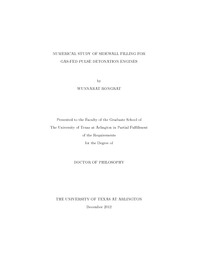
ATTENTION: The works hosted here are being migrated to a new repository that will consolidate resources, improve discoverability, and better show UTA's research impact on the global community. We will update authors as the migration progresses. Please see MavMatrix for more information.
Show simple item record
| dc.contributor.author | Rongrat, Wunnarat | en_US |
| dc.date.accessioned | 2013-03-20T19:11:22Z | |
| dc.date.available | 2013-03-20T19:11:22Z | |
| dc.date.issued | 2013-03-20 | |
| dc.date.submitted | January 2012 | en_US |
| dc.identifier.other | DISS-11957 | en_US |
| dc.identifier.uri | http://hdl.handle.net/10106/11534 | |
| dc.description.abstract | Pulse detonation engines for aerospace propulsion are required to operate at 50-100 Hz meaning that each pulse is 10-20 ms long. Filling of the engine and the related purging process become dominant due to their long duration compared to ignition and detonation wave propagation. This study uses ANSYS FLUENT to investigate the filling of a 1 m long tube with an internal diameter of 100 mm. Six different configurations were investigated with an endwall port and various sidewall arrangements, including stagger and inclination. A stoichiometric mixture of gaseous octane and air at STP was used to ll the tube at injection rates of 40, 150 and 250m/s. Phase injection was also investigated and it showed performance improvements such as reduced filling time and reduced propellant escape from the exit. | en_US |
| dc.description.sponsorship | Lu, Frank | en_US |
| dc.language.iso | en | en_US |
| dc.publisher | Aerospace Engineering | en_US |
| dc.title | Numerical Study Of Sidewall Filling For Gas-fed Pulse Detonation Engines | en_US |
| dc.type | M.S. | en_US |
| dc.contributor.committeeChair | Lu, Frank | en_US |
| dc.degree.department | Aerospace Engineering | en_US |
| dc.degree.discipline | Aerospace Engineering | en_US |
| dc.degree.grantor | University of Texas at Arlington | en_US |
| dc.degree.level | masters | en_US |
| dc.degree.name | M.S. | en_US |
Files in this item
- Name:
- Rongrat_uta_2502M_11957.pdf
- Size:
- 5.492Mb
- Format:
- PDF
This item appears in the following Collection(s)
Show simple item record


